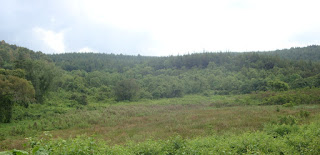There was a Perennial Spring….Where the Birds Once Sang
 Whenever I take nature walks, I’m at times amazed at
the quick change of the once breathtaking sceneries. Where thick canopied trees
once stood in forested areas have been rendered bare almost bereft of any vegetation, with exception of few
shrubs here and there or food crops where the areas had been farmed.
Whenever I take nature walks, I’m at times amazed at
the quick change of the once breathtaking sceneries. Where thick canopied trees
once stood in forested areas have been rendered bare almost bereft of any vegetation, with exception of few
shrubs here and there or food crops where the areas had been farmed.
Taking a hike the other day to Dundori hills within Dundori ward in Nakuru
County left me surprised as there was not a single stream or rivulet to be seen for miles within the said
hills.
Decades ago,
the hills were hardly visible, as a green cover of thick trees hid them
(however, from a distance, it was a blue cover. By the way, why do hills and
forests look blue from a distance?). But today, though there is a regenerating
forest, the hills are bare in many areas, with handkerchief sized plots where corrupt
forest officials have given peasants permits to farm. Back then, there were few
tributaries running like veins on one’s hand to join a swift flowing river that
meandered out of the forest and traced its course down the villages, and
checked its speed on three dams along its route before petering underground in
the final stage of its leg. It is known as Dawani River, which today, together
with its tributaries, is nothing but an empty channel in a Martian landscape
only coming to life once in a blue moon whenever there is a heavy downpour.
And somewhere
in the forest, there were marshy swamps where clear water bubbled from the ground
with the trickle from one forming part of a tributary, or, where the water
seeped from the rocks, local communities, depending on where the spring was
located, would lay claim to it and pipe its water first to a collection tank
and eventually to their homes. Few of the springs are no more, and where the
water is still available, it is pumped on a rotational basis to homes – once in
a week to be precise and for few hours.
The cultivation
of forest land had not helped the matters as fertilizer rich soils are washed
down the streams all the way to the dams during periods of prolonged rains such
that dams are left carpeted in a mass of green aquatic plants within a short time. Other
than its nutrients enriching the suffocating water weeds, there is no
deniability the chemical fertilizer finds its way to the food chain through the
use of the river’s water when domestic animals and plants are watered with the same. And what makes for a sick
observation is where the peasants farming the forest elect to wash their knapsack
sprayers on springs contaminating the piped water in the process!
As I sat
close to what was once a marshy spring (pictured above), I had the reflection when, decades
back, during school holidays, I and a gang of village boys would come armed
with pangas and harvest dry cypress
branches and tie them into bundles to be used as firewood in our respective homes. There was
a time we stopped at this particular spring and marvelled at the sight of the
many birds making merry…and there were different varieties of avian life like
long billed ones poking their bills deep to catch frogs, weaver birds jumping
from reed to reed while chirruping, sparrows making near suicidal dives before
soaring skywards, few parrots chattering….and so on.
But there
were no birds to be seen, barring the occasional one or two that flew past.
And where
the water once bubbled from underground was dry, though thick vegetation courtesy
of rain water had completely enveloped the place.
Whereas in
the past it would have been suicidal to walk across the marshy area without
sinking in the fine, soft mud, I had the luxury of walking across the dry though moist looking surface. If I had expected to see
frogs jumping or croaking in their hideouts, I was in for a shock. The place
was as quiet as a cemetery!
It will take
a miracle for the spring to regain its lost glory.
During my
days in the village school, we would draw water from the once mighty Dawani
River and sprinkle it on the dusty floors of the classrooms. But now the
teachers have resorted to asking the pupils to carry to school a litre of this
precious commodity every school day for ritualistic libation on the floors
before lessons commences. To say the river and one of the dams are just across
the fence is to be economical with the truth.
 |
| Dam |
And Dawani was
once a perennial river, just like the perennial spring where the birds once sang merrily.
More on environmental degradation here: https://paulkariuki.blogspot.com/2019/09/baruku-river-lifeline-of-lake.html
More on environmental degradation here: https://paulkariuki.blogspot.com/2019/09/baruku-river-lifeline-of-lake.html



Comments
Post a Comment